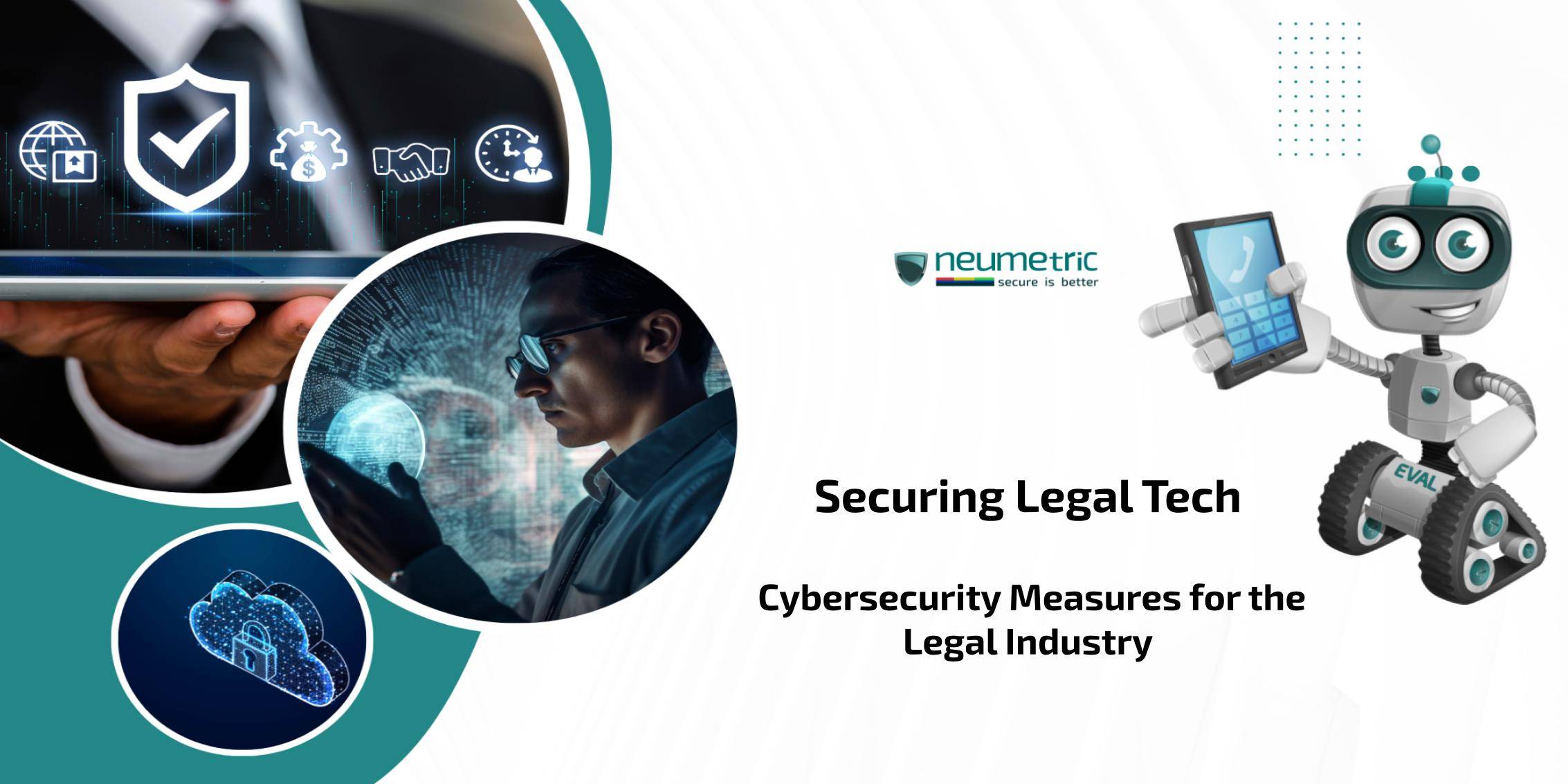Table of Contents
ToggleIntroduction
The legal industry, which was long entrenched in tradition, has undergone a seismic transformation as a result of the rapid integration of technology into its basic activities. Legal professionals now navigate a digital universe replete with cutting-edge tools & software, rather than huge paper files & manual research. This paradigm change has ushered in a new era for the legal profession, one distinguished by an increasing reliance on technology.
The sheer volume of sensitive legal information generated, saved & communicated electronically has soared as law firms & legal practitioners embrace digital platforms, cloud-based solutions & sophisticated software applications. This flood of digital data creates new opportunities for cooperation, faster procedures & enhanced client experiences. However, it also poses a tremendous challenge: the need to strengthen defences against a wide range of cyber threats.
In the current digitally driven legal context, the importance of cybersecurity cannot be emphasised. Legal professionals handle a wealth of personal information, ranging from client case details to proprietary legal tactics, all of which are increasingly vulnerable to cyber threats. The Confidentiality, Integrity & Availability [CIA] of this sensitive data are vital, hence strong cybersecurity measures must be implemented.
As the legal sector advances toward a world dominated by digital tools & technical breakthroughs, the vulnerabilities associated with this technological integration become more apparent. Cybersecurity is more than just a checkbox; it is the fulcrum that ensures client faith & confidence, the integrity of legal processes & the entire resilience of the legal ecosystem.
The Evolving Landscape of Legal Technology
The legal technology landscape is defined by a dynamic interaction of innovation & necessity. Technological advances have permeated all aspects of legal practice, providing radical solutions to age-old problems. The legal sector has undergone a technological revolution, from case management software that improves organisation & communication to e-discovery tools that speed up the retrieval of relevant material.
This progress, however, brings with it an inherent risk: increasing susceptibility to cyber assaults. While legal technology empowers lawyers, it also exposes the sector to a slew of dangers & weaknesses. Because of the interconnection of digital systems, reliance on cloud infrastructure & sheer volume of sensitive data, fraudsters have a large attack surface to exploit. Legal entities must confront the fact that technological progress is accelerating.
Real-world examples graphically depict the consequences of poor cybersecurity protection in the legal industry. Law companies of various sizes & notoriety have been victims of ransomware attacks, which hamper operations & jeopardise client confidentiality. Data breaches with far-reaching implications have become an unwelcome reality, emphasising the importance of legal professionals fortifying their cyber defences.
The legal industry’s increasing reliance on technology needs a matching commitment to cybersecurity. Recognising possible dangers & vulnerabilities as legal professionals navigate the growing world of legal technology should be accompanied by proactive actions to preserve sensitive legal information. The journey toward a safe legal IT environment is more than just a technological issue; it is a basic obligation to protect the legal profession’s ideals of secrecy, integrity & trust.
Key Cybersecurity Threats in the Legal Sector
Data Breaches & Client Confidentiality Concerns
In the technologically-driven landscape of the legal sector, data breaches pose a significant & pervasive threat. Law firms, entrusted with vast amounts of sensitive client information, have increasingly become targets for cybercriminals seeking to exploit vulnerabilities in their digital infrastructure. Case studies serve as poignant reminders of the real & immediate risks associated with data breaches in law firms.
Case Studies Illustrating Data Breaches in Law Firms
Several high-profile data breaches in law companies have highlighted the flaws in legal technology. For example, the Panama Papers leak in 2016 exposed a wealth of sensitive legal records, involving law firms in a global dispute. Similarly, famous legal firm Grubman Shire Meiselas & Sacks was the victim of a ransomware attack in 2020, resulting in the exposure of critical client data.
These cases demonstrate the sophistication of cyber attacks that legal entities confront. Attackers, who frequently use advanced approaches, take advantage of flaws in cybersecurity protections to get unauthorised access to client records, legal strategy & other sensitive information.
Implications of Compromised Client Confidentiality
The consequences of breached client confidentiality are far-reaching & diverse. Clients may suffer irreparable loss in addition to the immediate financial & reputational ramifications for the impacted legal business. Legal issues frequently entail confidential personal, financial or organisational information. A breach not only jeopardises the client’s trust in their legal counsel, but it can also have legal consequences, especially if the exposed material is utilised maliciously or publicly published.
Aside from legal ramifications, breached client confidentiality undermines the foundation of the attorney-client privilege—the cornerstone of professional ethics. The betrayal of this confidence threatens the fundamental foundation of the legal profession, in which clients must feel secure in disclosing the most sensitive aspects of their cases.
Ransomware Attacks Targeting Legal Organisations
Ransomware attacks have emerged as a particularly insidious threat to legal organisations. These attacks involve encrypting critical data & demanding payment—usually in cryptocurrency—for its release. The legal sector, with its wealth of valuable information, has become a prime target.
Consequences & Financial Impact of Ransomware Attacks
Ransomware attacks have implications that go beyond the immediate disruption of activities. Legal organisations risk losing their reputation, losing client trust & facing legal liabilities. The financial impact is significant, not only in terms of the ransom payment, but also in terms of incident response, recovery & the implementation of enhanced cybersecurity measures.
Furthermore, the nature of legal work needs immediate access to vital information. A ransomware attack can entail missed deadlines, court appearances & severe client unhappiness. As legal professionals deal with the fallout from such breaches, the need for robust cybersecurity safeguards becomes clearer.
Building a Cybersecurity Culture in Legal Firms
Importance of Employee Awareness & Training
Recognising that cybersecurity is a collective responsibility, legal firms must prioritise employee awareness & training programs. The human element remains a common entry point for cyber threats & educating staff on cybersecurity best practices is crucial.
- Employee Cybersecurity Best Practices Training Programs: Training programs that are effective should include a wide range of issues, such as spotting phishing attempts, using secure communication channels & practising excellent password hygiene. Regular & interactive training sessions can equip legal professionals & support workers with the knowledge & skills needed to recognise & minimise possible hazards.
- Developing a Vigilant & Accountable Culture: Aside from specialised training modules, cultivating a culture of attentiveness & accountability is critical. Employees must take responsibility for cybersecurity & understand the implications of lax procedures. Promoting a continual improvement mindset & disclosing any security concerns leads to a proactive cybersecurity culture.
Implementing Robust Access Controls & Authentication Measures
- Role-Based Access & the Principles of Least Privilege: Implementing role-based access controls & adhering to the concept of least privilege is one of the core pillars of cybersecurity within law firms. This entails restricting employees’ access to only the information & systems required for their specialised tasks. Legal organisations can mitigate potential damage in the case of a security issue by limiting access rights.
- Biometric Security & Two-Factor Authentication: Improving authentication measures is another key part of legal company cybersecurity. Two-factor authentication [2FA] adds an additional degree of protection by forcing users to give additional verification in addition to their password. Biometric security solutions, such as fingerprint or facial recognition, strengthen access controls even if login credentials are compromised.
Implementing these procedures not only protects sensitive legal information, but also ensures compliance with regulatory standards & industry best practices. As legal companies negotiate the ever-changing environment of cybersecurity threats, a complete approach that incorporates staff education, cultural reinforcement & robust access restrictions is critical for creating cyber resilience.
Securing Legal Software & Systems
Regular Software Updates & Patch Management
The robustness of legal tech security hinges significantly on the timely application of software updates & effective patch management.
- The Role of Timely Updates in Preventing Vulnerabilities: Timely software upgrades are critical for preventing vulnerabilities that cyber attackers could exploit. Updates are frequently released by legal software suppliers to patch known security problems, improve system efficiency & bring new features. If these upgrades are not applied promptly, legal systems may be vulnerable to known attacks, raising the risk of unauthorised access, data breaches &other security problems.
- Challenges & Best Practices in Patch Management: Patch management, on the other hand, is not without difficulties. Legal businesses are frequently faced with the problem of coordinating upgrades across multiple apps when dealing with complicated software ecosystems. Balancing the necessity for security with the possibility of disrupting regular operations necessitates a strategic strategy. Patch management best practices include doing detailed risk assessments & prioritising patches.
Choosing & Vetting Secure Legal Tech Solutions
A complete cybersecurity approach begins with selecting secure legal technology solutions. Key factors for evaluating legal software should include:
- Encryption: Make certain that the program employs strong encryption mechanisms (such as AES-256 or RSA-2048) to safeguard data during storage & transmission.
- Access Controls: Check to see if the program has granular access controls that allow companies to create & enforce user permissions.
- Audit Trails: Look for systems that keep extensive audit trails, which allow you to follow user actions & modifications to sensitive data.
- Vendor Security Practices: Examine software suppliers’ security practices, such as their approach to data protection, incident response & adherence to industry standards.
Regulatory Compliance & Legal Cybersecurity
The legal sector operates within a regulatory framework that demands strict adherence to data protection & privacy regulations. Key regulations impacting legal cybersecurity include the General Data Protection Regulation [GDPR], the California Consumer Privacy Act [CCPA] & other jurisdiction-specific laws.
GDPR, CCPA & Other Regulations That May Apply
GDPR establishes rigorous obligations for personal data processing & protection. The CCPA, which focuses on consumer privacy rights, applies to law firms that serve customers in California. Understanding the precise duties of these legislation is critical for legal organisations in order to prevent legal ramifications & reputational damage associated with noncompliance.
The Impact of Non-Compliance on Legal Firms
Non-compliance with data protection regulations can result in severe consequences, including hefty fines, legal actions & damage to the reputation of legal firms. Clients increasingly prioritise the protection of their personal information & any perception of lax data security practices can erode trust. Legal entities must recognise that regulatory compliance is not only a legal obligation but also a fundamental aspect of maintaining a reputable & trustworthy legal practice.
Ensuring Alignment with Industry-Specific Cybersecurity Standards
A proactive strategy to manage legal technology security is to align cybersecurity policies with industry-specific requirements. ISO 27001 is a set of international standards for information security management systems developed by the International Organisation for Standardisation [ISO]. The Cybersecurity Framework developed by the National Institute of Standards & Technology [NIST] is a comprehensive framework for improving cybersecurity.
Achieving & maintaining compliance with these standards involves a systematic approach. Legal firms should conduct regular risk assessments, implement security controls & establish processes for continuous monitoring & improvement. Adherence to recognised cybersecurity frameworks not only enhances the security posture of legal organisations but also demonstrates a commitment to best practices & due diligence.
Incident Response & Cybersecurity Insurance
Steps to Take in the Event of a Cybersecurity Incident
A well-defined incident response strategy is critical in the event of a cybersecurity issue for limiting damage & quickly restoring regular operations. The first steps are as follows:
- Identification & containment: Determine the type & scope of the incident as soon as possible. To prevent further damage, isolate impacted systems.
- Communication: Notify all relevant stakeholders, such as internal teams, clients & regulatory organisations, about the occurrence.
- Forensic Investigation: Conduct a thorough forensic investigation to determine the cause, scope & impact of the incident.
- Remediation: Remediation is creating & implementing a strategy to eliminate the danger & return affected systems to a secure state.
Importance of Regular Testing & Refinement of Response Plans
A comprehensive incident response plan is not a static document; it requires regular testing & refinement. Conducting simulated exercises, tabletop drills & scenario-based training helps identify gaps & weaknesses in the plan. Regular testing ensures that the response team is well-prepared to handle diverse cyber threats & adapt to the evolving cybersecurity landscape.
The Role of Cybersecurity Insurance in Mitigating Financial Risks
Cybersecurity insurance has become an integral component of risk management strategies for legal firms. It provides financial protection against the costs associated with a cybersecurity incident, including legal liabilities, notification costs & expenses related to system restoration. However, it’s crucial for legal professionals to thoroughly understand the coverage & limitations of their cybersecurity insurance policies.
Coverage typically includes:
- First-party coverages: Reimbursement for direct costs incurred by the insured, such as forensic investigations, system repairs & business interruption.
- Third-party coverages: Protection against legal liabilities arising from a cybersecurity incident, including legal defence costs & settlement payments.
Conclusion
The importance of cybersecurity for the legal business cannot be emphasised in the quickly expanding field of legal technology. As legal practitioners rely more on technology to simplify operations, improve client services & manage massive volumes of sensitive data, the necessity for strong cybersecurity safeguards becomes critical.
In summarising critical cybersecurity measures for the legal business, it is clear that protecting sensitive legal information necessitates a comprehensive strategy. This includes not just adopting technical solutions but also instilling in legal professionals a culture of knowledge, accountability & continual development. Legal companies must navigate a complicated terrain to protect the integrity of their operations & the trust of their clients, from data breaches & ransomware attacks to regulatory compliance & industry-specific cybersecurity standards.
Legal professionals must consider cybersecurity as a fundamental duty as a call to action. Adoption of technology should be supported by a simultaneous commitment to safeguarding client information & respecting the legal profession’s ethical norms.
FAQ
Why is cybersecurity crucial for the legal industry?
Cybersecurity is essential in the legal industry to protect sensitive client information, maintain trust & uphold the integrity of legal processes in an increasingly digitised environment.
What are common cybersecurity threats faced by law firms?
Law firms commonly face threats such as data breaches, ransomware attacks & phishing attempts that compromise client confidentiality & disrupt legal operations.
What role do regular software updates play in legal tech security?
Regular software updates are crucial in preventing vulnerabilities & enhancing security by addressing known flaws & strengthening the resilience of legal tech systems.





